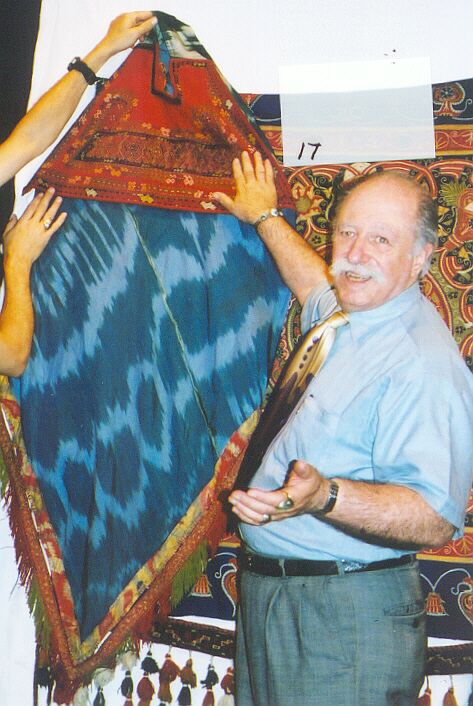
Part 2 - Rug Morning Session at The Textile Museum with Saul Barodofsky
There seem to be a lot of Turkmen embroidered hats on the market at the moment. Saul had a nice one that he had "once" momentarily. Unfortunately, I wasn't fast enough with my camera.

Number (14) is the heavily decorated end of a Central Asian tent band.

Number (15) is a very heavily woven Balouch salt bag. Hard to get the richness of these dark color up in this image.

Next was a very small embroidered women's bag. You are seeing it here opened up. It was folded double and sewn for use. Good embroidery and good color.

Number (17) was an embroidered woman's head piece, lined with an ikat fabric.

The other side was better, I think, but I had to change film at this point and missed it.
This round Central Asian piece was a fairly young bag made of felt. It was graphically attractive.

Saul advised anyone with felt pieces to actively protect them against moths. (He uses a spray, called SLA.)
Saul prefaced the next piece by saying that in the old days in many countries, dress was quite precisely, village-specific.
People could tell by looking at your dress whether you lived in their village or what village you were from. He
then showed this very interesting "apron" which he said was part of the women's dress for a particular
village, likely in Greece, since that is where it was purchased.

I said from the audience that I have only seen, firsthand, one other textile identified as an "apron."
It was a Kurdish one laying in the bottom of a glass case in the museum in Springfield, Massachusetts, in such
a way that I was not able to take an intelligible photo of it. But I was triggered by Saul's comment to dig out
a book on "Traditional Bulgarian Costumes and Folk Arts," that I bought recently on eBay. It contains
only two pieces specifically identified as aprons but presents a number of complete 19th festival costumes with
very precise geographic attributions. I'm going make a little detour from Saul's presentation here to show you
a few of them, without comment, excepting the catalog description.
First, are two items specifically identified as aprons. They are the back and front aprons respectively of the
women's costume for a particular district. Piece (20) (I have not scanned numbers onto these catalog images) is
labeled "Back apron ,,vulnenik" of the two-apron women's costume. District of Vidin, end of the 19th
century."

The second apron is (21) "Front apron of the two-apron type of women's costume. District of Vidin. End of the 19th century.

To make Saul's point about village specific costumes though, here are four different full-costume examples.
Numbe (22) is a "Maiden's costume for the ritual ,,lazarouvane" from the village of Pirin, district of
Sandanski. Second half of the 19th century.

Number (23) is "Young married woman's festive costume from the village of Satovcha, district of Gotse Delchev,
second half of the 19th century.

Number (24) is "Woman's festive costume from the village of Mirkovtsi, Skopije Montenegro, 19th century.

Number (25) is "Woman's festive costume from the region of Bitolja. Early 19th century.

There seems no question from these examples that there was very geographic-specific dress in the villages of
Turkey, Greece and nearby countries.
I have a lot of admiration for the Bulgarians for having preserved and documented these village costumes in such
detail.
OK, on with Saul's presentation.
He next presented a small, finely embroidered bag face, which I think he said is Greek.

The embroidery on this piece is exquisite.
On the left side of the front board, Saul had pinned up a group of small Central Asian(?) weavings.

The two in the center are bags. The four at the sides are "potholders." I thought the pair on the
left especially attractive.
Saul demonstrated how one set of potholders fit on one's hands.

When one came into the room on this rug morning, one was facing this fairly sizable textile in the center of the front board.

It is an embroidered item of piece-work from Reshti, in the Azerbaijani section of Iran. It is a "sofreh,"
or eating cloth. Saul used the phrase, "a stone is heaviest where it sits," to suggest that there are
some textiles that are more expensive overseas than they are here. This, he said, is an item to buy here rather
than there for that reason.
This graphically attractive piece was embroidered with chevron-like forms and diamonds.

They reminded me of some Yomut Turkman pile designs. Saul said that this piece is a Byzant embroidery. He added, it's called Byzant - not because of its age - its late 19th or very early 20th century - late Ottoman in culture - but because of the people who wove and then embroidered it - used it as a cover for the baby cradle and many have cross designs on them to ward off the evil eye